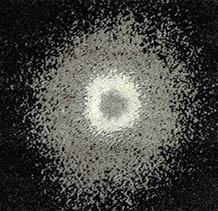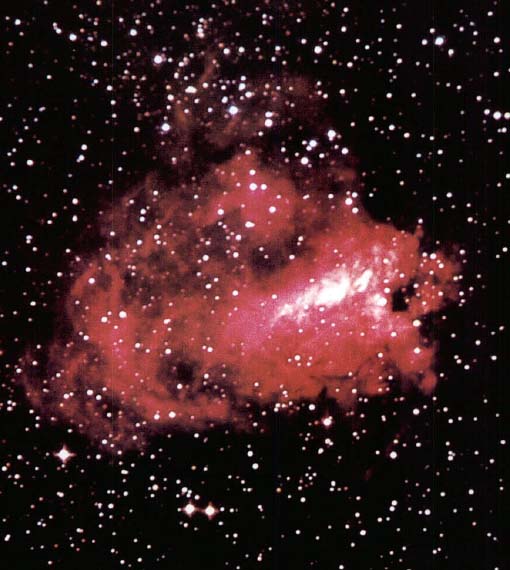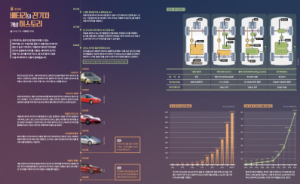탱고는 아르헨티나에서 시작된 우아한 무도장 춤으로서 (영화배우였던) 루돌프 발렌티노같은 사람들에 의해 유행됐다. 필자가 좋아하는 탱고에선(이모진 코카란 사람이 만들었던가?) 장미 한송이가 등장하는데 남자의 입술에서 꽃이 여자의 입으로 전해질 때 여자주인공이 깜짝 놀란 표정을 지으면서도 용감하게 꽃을 전달받아 관객들로 하여금 과연 장미꽃의 가지에서 가시들이 사전에 제거됐던가를 궁금하게 만든 장면이다. 그런데 가끔 블랙홀에 관한 최근의 기사들을 훑어보면서 필자는 흥미롭게도 탱고를 연상하곤 한다.
탱고를 추는데는 보통 두명이 필요하다. 하나만의 블랙홀은, 적어도 현재 인간의 기술적 시각으론, 거의 눈에 보이지 않는다. 이론적으로 블랙홀은 질량높은 별이 중성자성(星) 단계를 넘어 파괴되면서 생겨난 엄청난 중력에 물질이 소위 '특이점'으로부터 탈출하는 것을 막음으로부터 태어난다. 그 결과가 블랙홀이라 불리는 것은(이 이론은 물리학자인 존 휠러가 처음으로 지었다) 블랙홀에 가까이 있는 것이라면 그 어떤 물질이나 빠져들어 영원히 갇혀버리기 때문이다.
만약 블랙홀이 쌍별이 춤추는 무대의 일부분이고 그중 하나는 보통 별이라면 블랙홀의 중력장(場)은 이 보통별로부터 물질을 끌어들이게 된다. 블랙홀 주변에 물질의 '증량원반'이 생기는 것이다. 이 증량원반으로부터 물질은 블랙홀 속으로 빠지면서 운동에너지를 얻게 되는데 이 에너지는 곧 X선이라는 빛으로 변형된다. 다행스럽게도 우린 이 X선들을 감지할 수 있다.
우리의 은하계에선 백조자리의 한 별로부터 X선이 지난 1965년에 처음으로 탐지됐다. 1971년에 이르러 X선의 비규칙적 변형이 발견됐다. 이러한 발견이 천문학자들로 하여금 시그너스 X-1이라 불리는 별이 나란히 회전하는 거대한 푸른 별 둘레로부터 물질을 흡수하는 블랙홀이라고 단정짓는데 도움을 주었다.
또 다른 블랙홀이라고 추정되는 것들도 요즘은 자주 나타나곤 한다. 우리의 은하계에서도 둘이상의 후보들이 발견됐다. 1975년 모노세로 성좌에서 A0620-00이라는 쌍별이 발견됐다. 최근 천문학자들은 이 쌍별중 눈에 보이는 오렌지색의 별이 빠른 속도로 공전함을(적어도 1초에 4백60km) 밝혔는데 깜깜한 상대별로부터 멀리 떨어져있음을 감안할 때 그 깜깜한 별은 엄청난 질량임에 분명하다. 여기에 대한 논리적인 설명을 하자면 바로 그 깜깜한 별이 블랙홀일 것이라는 점이다.
우리 은하계에서 가장 최근 블랙홀 후보로 등장한 것은 V404 시그나이라는 쌍별로서 지구로부터 5백광년 멀리있는 것이다. 지난 1938년 눈에 보이던 어느 별 하나가 갑자기 빛나는 신성(新星)이 되고 1989년엔 X선을 분출함이 일본의 인공위성인 긴자에 의해 발견됐다. 여기서도 이 별이 다른 깜깜한 동반자 주위를 매우 빠른 속도로 공전해 그 동반자가 아마도 블랙홀일 것이라는 추정을 하게 만들었다. 이 V404에 관해 탐구한 스페인 천문학자들은 이 별들이 세 물체들의 복합체로서 그 세번째는 적색왜성이라고 생각한다. 그렇다면 복잡한 춤이 되지, 결코 탱고는 아닌 것이다.
별이 블랙홀과 춤춘다는 것은 매우 위험한데 이는 블랙홀을 맴도는 별이 언젠가는 블랙홀에 의해 완전히 삼켜져 버릴 것이라는 이론이 가능하기 때문이다. 사실인즉 콤프턴천문대에서 나온 최근 자료에 따르면 우리 은하계 밖에서 발생한 강한 X선의 폭발은 어쩌면 뭉게지고 납작해지고 열이 가해지고 삼켜지면서 최후를 맞으며 X선을 뿜어내는 별들에 그 원인이 있는지 모른다.
최근엔 우주의 중심부에 있는 블랙홀에 관한 많은 기사들이 쓰여졌다. 우리의 은하계에도 블랙홀들이 있겠으나 우린 다른 은하계에 보다 확신감을 갖기 시작했다. M32는 조그마한 타원형 은하계로서 우리 은하계로부터 2백30만광년 떨어져 있다. 이 은하계의 중심부엔 수많은 별들이 뭉쳐져 있고 이 중심을 어찌나 빨리 회전하는지 블랙홀이 아닐수가 없다.
허블천체망원경은 5천2백만 광년 멀리있는 처녀자리 성단내에 있는 M87 은하계의 중심으로 초밀집된 형태의 별들이 끌리고 있음을 보여주었다. 대부분의 타원형 은하계는 초질량의 블랙홀을 지니고 있을 가능성이 높다고 생각되는데 이는 타원형이 만들어진 것이 꽤나 난폭한 춤을 춘 두개의 나선형 은하계의 충돌에 의한 것일는지 모르기 때문이다.
천문학자들은 이제 은하계 중심부로부터 끌어당기는 인력을 측정함으로써 그 질량을 예측할 수 있는 기술을 갖고 있다. 공전하는 별들의 속도는 그들이 발하는 빛의 파장의 변화를 관측함으로써 결정된다. 천문학자들인 존코멘디와 더글라스 리치스톤은 우리로부터 3천만 광년 떨어진 은하계엔 NGC3115를 연구했다. 그 결과 이 은하계의 핵은 빨리 공전하고 있을 뿐만 아니라 주변의 별들을(보다 가속화되는 속도로) 빨아들이고 있는 것으로 밝혀졌다. 어쩌면 이것이야말로 현재까지 발견된 블랙홀중에서 가장 큰 것인지 모르며 깜깜한 동반자 별 하나와 간단한 탱고춤을 추는 다른 별들과의 큰 차이가 있다. 우주 중심부의 질량높은 블랙홀들은 많은 별들과 춤추며 이 별들을 없애버리고 있는 것이다.
가끔씩 천문학자 자신들도 아이디어를 주고 받고, 장미가지에 가시가 돋아있었나 없었나를 따지는 등 탱고를 추고 있다. 아르메니아 천문학자 한명과 미국 천문학자 한명은 둘다 각기 그렇게도 난폭스럽고 파괴적일 듯한 우주의 중심이 사실은 그와 정반대라고 가정한다. 그들은 바로 우주의 중심부에서 새 은하계의 핵이 만들어지고 있다고 생각하는 것이다.
둘이서 춤추는 별들의 무대나 많은 별들과 춤추는 엄청난 은하계의 핵 세계에서 무슨 일이 일어나고 있든 간에 천문학자들이나 천체물리학자들은 진실을 찾아내고자 심혈을 기울이고 있다. 따라서 앞으로도 이 칼럼에선 간간히 블랙홀에 관한 새로운 정보나 이론을 논하게 될 것이다. 필자와 블랙홀을 논하는 탱고를 함께 출 사람은?

The tango is a graceful Argentinian ballroom dance made popular by the likes of Rudolph Valentino. My favorite version(was it Imogene Coca's?) featured a rose transferred from the male dancer's teeth to those of the female, who looked surprised at the result but bravely carried on, leaving the audience to wonder if the rose's thorns had been removed. Sometimes when I wade through the stack of recent articles about black holes I am perversely reminded of the tango.
Ordinarily it takes two to tango. A black hole by itself, at least from the point of view of current human technology, is virtually invisible. Theoretically, a black hole occurs when a massive star collapses past the neutron-star stage, the immense gravitational field preventing matter from escaping what's called a "singularity." The result is called a black hole(first named by physicist John A. Wheeler) because anything coming near it would fall in, forever trapped.
If a black hole happens to be part of the cosmic dance of a binary-star system, and its companion is a normal star, then the gravitational field of the black hole draws matter from the normal star. An "accretion disc" of matter forms around the black hole. As the matter from the accretion disc falls into the black hole, it gains kinetic energy that's converted into radiation-X-rays. Fortunately, we can detect these X-rays.
In our own galaxy, an X-ray source in Cygnus was first detected in 1965. By 1971 irregular changes in the X-rays were found. These helped astronomers decide that the X-ray source called Cygnus X-1 was probably a black hole, drawing matter from a huge blue star revolving in tandem with it.
Other possible black holes are now found frequently. Two more candidates have been discovered in our own galaxy. In 1975, the binary system A0620-00 was discovered in the constellation Monoceros. Recently astronomers found that the binary's visible orange star is revolving rapidly(at least 460 kilometers per second), but at such a distance from its dark companion that the latter must have huge mass. The logical explanation is that the dark companion is a black hole.
The latest black hole candidate found in our galaxy is in the binary system V404 Cygni, 5,000 light years from Earth. In 1938 a visible star there had gone nova, and in 1989 produced a burst of X-rays discovered by Ginga, the Japanese satellite. Again, the visible star orbits its dark companion rapidly enough to make it likely that the companion is indeed a black hole. The Spanish astronomers who did the work on V404 postulate that it may be a complex system of three objects, the third being a red dwarf. This makes for a complicated dance, and certainly no tango.
A star's dance with a black hole is dangerous, for it's theoretically possible that the star revolving with a black hole may eventually be completely swallowed up by it. Indeed, recent data from Compton observatory indicates that powerful bursts of X-rays originating outside our galaxy may be caused by stars that are squashed, flattened, heated up and swallowed, giving off X-rays as they fall to their doom.
Lately there's been a great deal written about black holes in the center of galaxies. Our own Milky Way galaxy may contain black holes, but we're getting more certain about other galaxies. M32 is a dwarf elliptical galaxy only 2.3 million light-years from out own. It has stars packed together near the core, around which they revolve too rapidly for it to be other than a black hole.
The Hubble telescope shows that a super-dense concentration of stars is also being pulled toward the center of galaxy M87, in the Virgo Cluster, 52 million light-years away. It's thought likely that most elliptical galaxies contain super-massive black holes, the result of the way ellipticals were probably formed-from the collision of two spiral galaxies-a violent dance!
Astronomers now have a technique for estimating the central mass of galsxies by measuring the gravity they generate. The velocity of revolving stars is determined by watching changes is the wavelength of their light. Astronomers John Kormendy and Douglas O. Richstone studied galaxy NGC 3115, 30 million light-years from us.
Apparently, its nucleus is not only spinning fast, but drawing in (and increasing the velocity of) the surrounding stars. This may be the biggest black hole yet discovered, and is a far cry from the simple tango of one star dancing with one dark companion. Massive black holes at galactic centers dance with-and probably kill-many stars.
Occasionally, the tango is being danced by the astronomers themselves, passing ideas back and forth, and arguing as if the rose still had thorns. An Armenian and an American astronomer both postulate that the galactic centers that seem so violently destructive are actually the opposite. They think nuclei of new galaxies are being generated at the cores.
Whatever is going on with those dancing duos, or with those amazing galactic cores that dance with many stars, the astronomers and astrophysicists are hard at work to find the truth. In the meantime, new information and theories about black holes will be discussed in this column from time to time. Tango, anyone?

















